|
|
Reviewed by Glenn Erickson
After 1968's 2001: A Space Odyssey filmed science fiction took a big downturn. There was a new awareness of the genre, but the profundity and technical near-perfection of Kubrick's movie gave most producers the general impression that Sci-fi was out of their reach. In the confusion of the Easy Rider phenomenon Universal delayed releasing its very good Colossus: The Forbin Project for two years, unsure whether anyone would want to see it --- nobody could best 2001 for hardware, that's for sure. Six years later, Sci-fi was still in a funk, with Robert Wise's serious The Andromeda Strain promoted more like a spy thriller. Of the two bigger ecology themed Sci-fi pictures, the hardware-oriented Silent Running did middling business and the grim Soylent Green a little better. MGM's jokey, slapdash Westworld pointed to a Sci-fi future with more exploitative gimmicks. Disappointingly, the ambitious films that favored cerebral material did even worse. The marvelous Slaughterhouse-Five is a brilliant transposition of Kurt Vonnegut to the screen, but hippy-trippy ethereal Sci-fi apparently appealed to a tiny slice of the movie-going pie. Distributors tended to bury / ignore these pictures, as happened to the worthy far-out feature Phase IV.

Then in 1974 the accomplished director John Boorman came out with his Zardoz. Boorman was hot at this time; had he wanted to make a Deliverance 2 he probably could have written his own deal. He instead doubled back into the semi-abstract territory that had served him so well in the excellent Point Blank, a psychedelic gangster film seemingly filtered through Alain Resnais' time travel-memory paradox from La Jetée. Boorman's Hell in the Pacific was almost as strange, a war movie that reduced its combat scenario to lonely landscapes, men caked in mud and long, long camera takes. Zardoz was certainly promoted, at least in Los Angeles. I clearly remember teaser posters around Westwood with bold white lettering on black: "I have seen the future. And it doesn't work." Boorman was now going to do Science Fiction: What could we expect?
Zardoz takes place in a dystopian future hundreds of years in the future. A ruling elite known as "Eternals" uses heightened mental powers to sustain an unnatural and unhappy social balance in a sanctuary called The Vortex. The Eternals have perfected the ability to live forever, but are losing basic aspects of their humanity, like ambition and sexuality. They've already consigned the last non-immortal generation to a perpetual senility, and many of their own have become "Apathetics," who simply stand about refusing to engage in any life activities whatsoever. One Eternal, Arthur Frayn (Niall Buggy) has taken charge of the savages that live outside The Vortex, the "Brutals". Flying about in a giant stone head, Frayn has created a false God named Zardoz that dispenses guns and ammunition to his chosen tribe, the "Exterminators." The Zardoz God teaches that killing is good and procreation evil. One Exterminator, Zed (Sean Connery) shoots Frayn and penetrates The Vortex, upsetting the society within. May (Sara Kestelman) wants to study Zed, while Consuela (Charlotte Rampling) thinks he's dangerous and must be destroyed. Zed motivates the Apathetics into activism. He eventually goads the Eternals into seeking Death, which he and his Vortex-invading Exterminators are only too ready to dish out, wholesale.
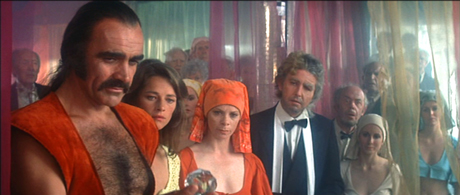
The more than slightly simplistic setup in Zardoz would sink a film that wasn't so aggressive; this is the kind of violent dystopia that requires a lot of setup for a minimal payoff. Although well written, the movie spends at least 80% of its time explaining itself. Ten years before it could have been a BBC radio show, and if it were not for the visual imagination of Boorman and his cameraman Geoffrey Unsworth, it would surely be as talky an ordeal as the static (but fascinating) Creation of the Humanoids. The world of The Vortex is conceived practically on the same level as Pepperland, surrounded by an Arch Oboler-like force field. Instead of Blue Meanies and Snapping Turtle Turks, post-apocalyptic marauders are eager to get inside and cause havoc. Luckily Boorman takes these high-concept eccentricities completely seriously, and good photography and excellent acting prevent his show from collapsing of own weight. Zardoz never really comes together but the vigor of Boorman's direction is often its own reward. Even on my fourth viewing, the ending remained particularly murky. Yet the film is ambitious in every way, and not to be casually dismissed.
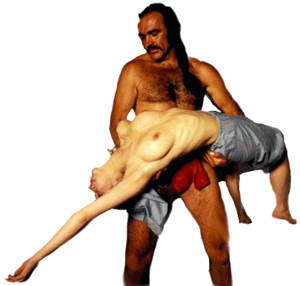
There's also the saving grace of Sean Connery, whose believability factor guarantees that anything he's in will play for at least an hour. Despite his costume of crimson loincloth, bandoliers and swashbuckling boots, sporting a ponytail wig, Sean Connery's star authority accomplishes the impressive feat of not being laughed off the screen. (Note -- Connery's "Scotland Forever" tattoo is clearly visible in at least one shot.) On the contrary, the burly actor is committed to breathing life into Boorman's thick fantasy. Even co-star Charlotte Rampling is more animated than usual, giving a lively performance as opposed to her more frequent set of silent, compelling poses.
Zed stays alive by flexing his virility, a lost quality in this verdant neck of the woods. The other Irish and English pro actors likewise hold up their end of the bargain, as they stroll through underwhelming sets in foolish-looking costumes. They debate Zed's fate and condemn one of their own to forfeit his immortality. Like a modern doomsday cult, the Eternals are eventually inspired to embrace a violent mass death. At the climax dozens of actors mill about and wave their arms in what looks like a hippie pageant, yet manage to maintain their self-respect.
Visually, Zardoz is an uneven mix. Geoffrey Unsworth's precise photography makes the most of the available resources, and his in-camera tricks with mirrors and front- and rear- projections are often quite effective. But the film is just too cheap for its subject matter. We're supposed to be witnessing the evidence of hi-falutin' Sci-fi concept after another, and seeing Connery pretend to fall between mirrors into a new dimension doesn't cut it. The images of people with movies projected on them look interesting, but not transcendental. The special effects just don't make the grade, consisting almost entirely of insubstantial futuristic trimmings made from plastic bags and balloons. The giant floating Zardoz head is never very impressive. It's a large mockup suspended by a crane in forced perspective, but in a wide shot over a pretty lake it cannot throw a proper shadow. The main angle (below) of the Zardoz head has the look of a wholly unconvincing paste-up.
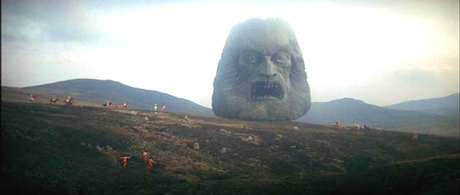
The 'golden' early 1970s were also years of sexual exploitation. Even the actress-friendly Robert Altman had a habit of asking his women to strip down as often as possible. John Boorman confects a generous show of nudity every few minutes, more than what was normal even in much cruder, exploitation-oriented product. His futuristic society is set up as matriarchy, but not one organized on feminist lines. Although there are zero children in this future world, sex and procreation are frequent subjects of debate. The immortals' scientific investigation of Zed's ability to spontaneously erect himself is amusingly direct, especially with Sean Connery standing there looking so casually self-satisfied. Although Connery's fan base is surely pansexual, the film's main voyeuristic appeal is to men. If there's a profound science fiction philosophy to be gleaned from Zardoz, it is hard to pick out in a fast moving, confusing wash of pseudo-abstract dialogue and distracting nudity.
A campy meditation on brutality vs. intellectualism, Zardoz does a lot with its mirrors and projections yet doesn't satisfy our eye for science fiction futurism. Ten years later the graphic genius Terry Gilliam would do much better with fantasies and dystopian science fiction tales that deliver astounding visuals without a staggering effects budget. 1 I saw Zardoz twice in theaters with audiences hungry for extravagant fantasy. They liked Connery, the sex humor, and some of the violence. They were even receptive to the complicated setup that reveals that Zed's stealth mission into the Vortex was not entirely his idea. But Boorman lost almost everybody in the scene in the old library, when Zed sees a particular book's title and learns the true nature of his feared god, Zardoz. I don't know how it plays now, but for us the reveal was a shaggy-dog letdown, a true Peggy Lee moment: "Is that all there is?"
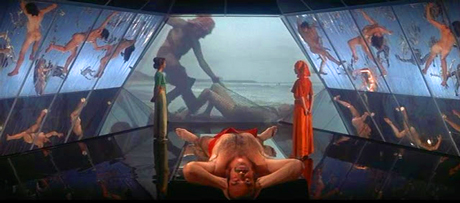
Twilight Time's handsome Blu-ray gives John Boorman's Zardoz a welcome high polish. The label is so careful in its choice of titles to license, their new releases are all but guaranteed to be technically flawless. 2 The old DVD from 2001 couldn't resolve Geoffrey Unsworth's frequently misty soft-focus shots, turning some of the handsome Irish exteriors into mush. Most of the film's effects rely on mirror reflections and projected images, which the added resolution restores back to their original level. Grain is reduced while the accurate colors and contrast are sometimes too subdued. Now we can fully appreciate Boorman and Unsworth's frequently complex shots. They really worked hard on this picture, with few resources, to keep it visually arresting.
David Munrow's music and several effective classical themes come across well on TT's Isolated Score Track, and some radio spots and the original trailer are included. The full-length commentary by director Boorman is a keeper. His candidly self-critical thoughts on the film are fascinating: he's sufficiently secure to admit that he now (2001) considers Zardoz a somewhat dated and silly affair. Boorman's integrity makes the cardboard movie come to life again, as you correlate his reminiscences with what he created. This was 1973, after all, the era of cinematic embarrassments from all across the movie-land spectrum. Compared to many Zardoz is a respectable example of slight directorial overreaching. Boorman talks about working with Connery and details the man's acting style and attitude toward movies. Boorman's opinion on the debasement of movie reality by CGI put a knot in Savant's throat. Filmmakers today are up against such barriers that it's remarkable that good films can be made.
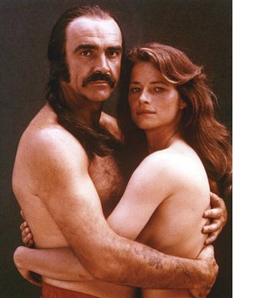
In a new commentary TT spokesman Nick Redman discusses Zardoz with writers Jeff Bond and Joe Fordham, the authors of a new book on the making of Planet of the Apes. They're personable, knowledgeable and steer the discussion in interesting directions, even if they seem unduly impressed by the film's weaker effects and occasional laughable dramatics. The track is an excellent counterpoint to Boorman's first-hand authorial testimony.
Julie Kirgo's liner notes add one more note of balancing sanity. Boorman had the integrity to turn down The Exorcist and struggled mightily to give Zardoz an expensive look on a tiny budget -- even Sean Connery took little money for the film. She divines the good qualities in Boorman's Dune- like dystopia, and picks up on the Buster Keaton connection as well. Zardoz was another ambitious Sci-fi bust of the early 1970s. As Bond and Fordham say, it's no wonder that George Lucas went met such stiff resistance when he was trying to sell his "Adventures of the Star Killer: Episode I -- The Star Wars."

On a scale of Excellent, Good, Fair, and Poor,
Zardoz Blu-ray rates:
Movie: Good + / -
Video: Excellent
Sound: Excellent
Supplements: Isolated Score Track, commentary with Director John Boorman; commentary with Film Historians Jeff Bond, Joe Fordham and Nick Redman, radio spots, trailer, liner notes essay by Julie Kirgo.
Deaf and Hearing Impaired Friendly?
YES; Subtitles: English
Packaging: Keep case
Reviewed: April 12, 2015
Footnotes:
1. Boorman does pull off a couple of bravura fantasy visual set pieces. The best is the finish, which takes Connery and Rampling on a rapid journey through their future lives together as a proud married couple, raising a son from a little boy to a strapping Exterminator Junior. The problem is that the sequence is a verbatim conceptual steal from Buster Keaton, who used it forty-seven years earlier to give a Buñuel-worthy finish to his silent comedy College.
Return
2. Now when I see a desirable title announced by Twilight Time, I don't think, "I hope it looks decent" but instead, so-and-so studio must have remastered that."
Return

Text © Copyright 2015 Glenn Erickson
See more exclusive reviews on the Savant Main Page.
Reviews on the Savant main site have additional credits information and are often updated and annotated with reader input and graphics.
T'was Ever Thus.
Return to Top of Page
|

